Hippeastrum
A bright representative of the amaryllis family, which almost all lovers of indoor plants have grown at least once. Caring for this representative of bulbous plants is simple: the main thing is to place it under bright diffused light.
It is undemanding to air humidity, but you should not overwater it (especially during the dormant period). When replanting, it is better not to disturb the roots, carefully transferring them to a larger pot and adding soil.
Important! A third of the bulb should remain on the surface.
The flowering period of hippeastrum is late winter – early spring. In September-October the plant goes into hibernation and can shed not only flowers but also leaves.
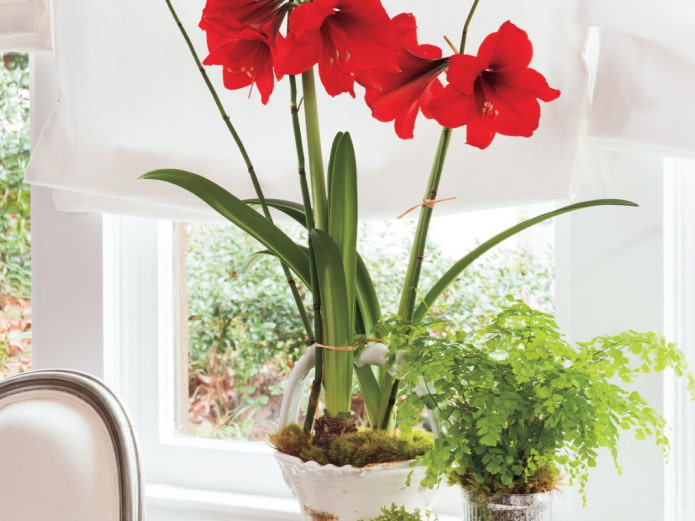
Zephyranthes
Belongs to the amaryllis family (like daffodils or snowdrops). The leaves are narrow, long, and resemble onion feathers from afar. It blooms most often in spring, but sometimes the inflorescences open in winter or summer – depending on the variety and growing conditions. Flowers are usually white with a yellow center (similar to crocus), some species have pink and red flowers.
To enjoy the small decorative conditions, place the pot with zephyranthus in a sunny place and provide it with moderate (but regular!) watering.
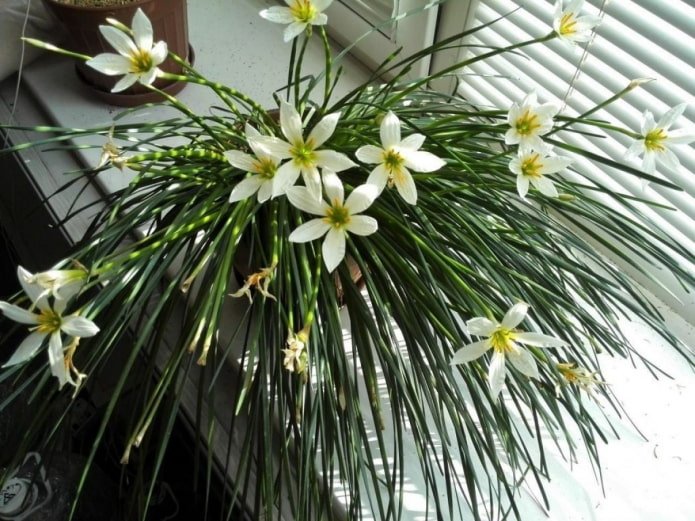
Rhodophiala
The second plant on our list is from the Amaryllidaceae family. In the wild, it grows in a subtropical climate, so for successful cultivation, you will have to create similar conditions in the apartment.
This is actually not difficult to do: protect the flower from direct sunlight, provide a stable temperature of about 20-24C.
The buds are large, reminiscent of a lily. They grow on a high peduncle, 1-2 pieces each. The flowers of the bull’s blood lily appear in August-September.
Important! Rhodophiala is considered a rather capricious and difficult to grow plant, not suitable for beginners.
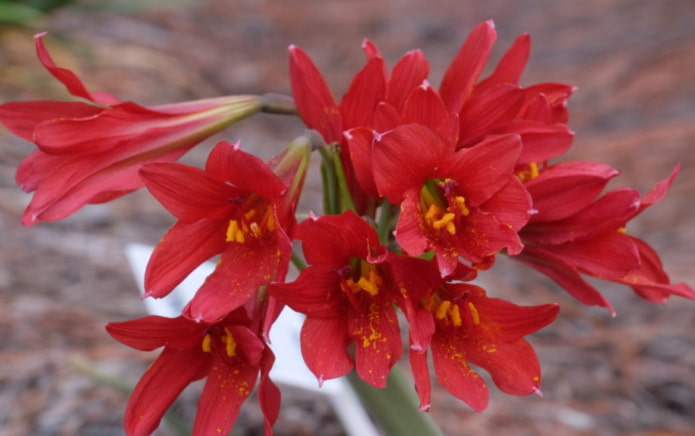
Freesia
This indoor flower feels great not only indoors, but also on the balcony or in the garden. In appearance, it resembles an iris – in fact, it belongs to this family.
The flowers are small, can be of absolutely different shades: purple, pink, yellow, white, red. The aroma of blooming freesia is incredibly pleasant: somewhat reminiscent of the smell of lily of the valley.
To enjoy the beauty and aroma, be sure to provide a long daylight hours of ~14 hours a day. But the sun should not be scorching – it is best to place the flowerpot on the eastern windows. The second nuance is that freesias do not like drafts, so they should be placed away from open windows.
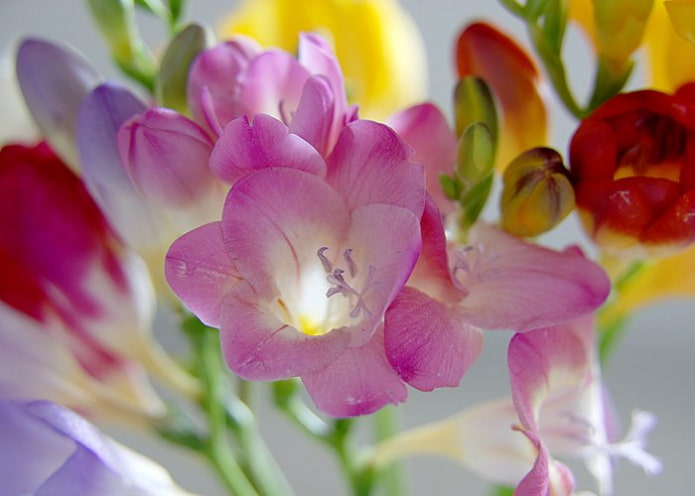
Amaryllis
By its name, it is easy to guess what genus this perennial belongs to. Amaryllis is almost a twin of hippeastrum, but these are two different species of the same family.
Firstly, amaryllis blooms more abundantly – it throws out 10-12 flowers at a time, which emit the most delicate aroma. However, its foliage is scantier and smaller, leaves appear during or after the flower is thrown out.
Since bulbous indoor plants are a kind of “hamsters” storing nutrients for the next season, amaryllis needs to be fertilized generously in spring and summer. Then you can confidently expect vigorous flowering already in August-September.
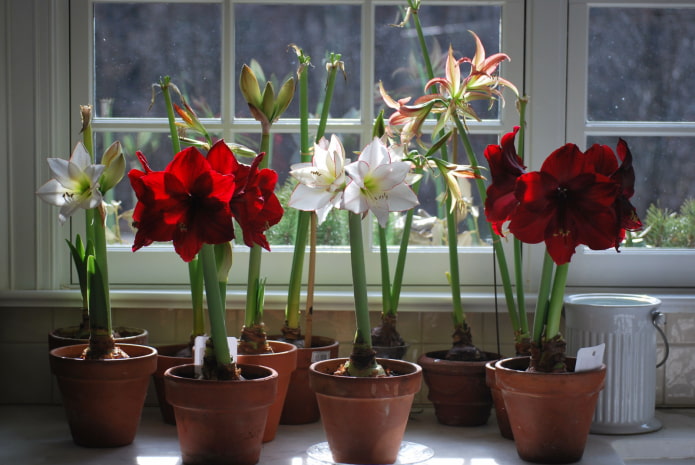
Hyacinth
Perhaps one of the most spring flowers that is easy to grow at home. Bright clusters with small flowers of lilac, red, yellow, pink colors appear already in February-March: therefore, at the end of winter, variegated hyacinths can be found for sale in most stores.
If you want the hyacinth to delight you with its flowering for several more years, remove the pots with bulbs after flowering and the fall of the leaves for storage in a cool place (17-18C). After 3 months, they can be put out again in a well-lit place and soon expect abundant flowering.
Important! Keep flowers away from children and animals – the plant contains the alkaloid lycorine, which can cause severe poisoning.
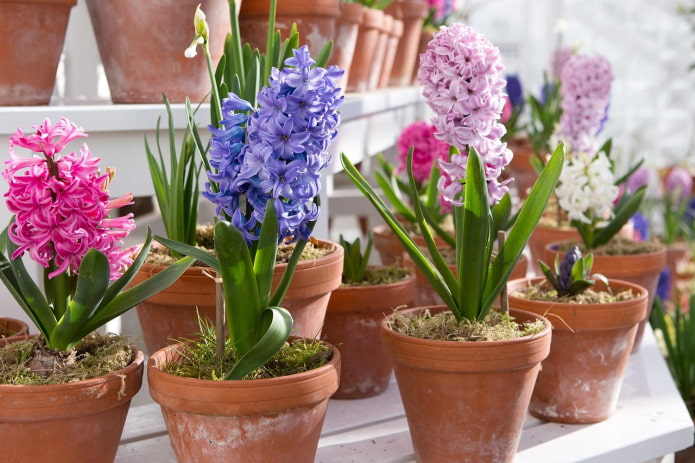
Narcissus
Another harbinger of spring is the wonderful sunny narcissus! They are most often grown in gardens, but narcissuses are also quite suitable as houseplants. The bulbs are stored in a cool place between plantings, planted in the ground in November, and put in a bright place in mid-February: then the daffodils will bloom around March 8.
Daffodils are considered to be unpretentious in terms of watering and fertilizing – the main thing is to prevent the bulbs from rotting.
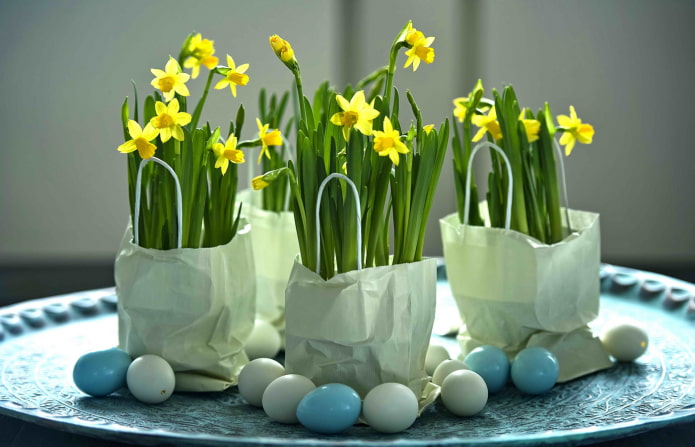
Hymenocallis
Another representative of the amaryllis family. The bulbs are large (9-10 centimeters), the leaves are long (reaching 100 cm). But hymenocallis are grown not for their greenery, but for their unusual flowers. From a white cup, reminiscent of a petunia, 6 thin long petals extend, simply hanging or curled back.
If you are looking for a flower for a southern window – this is it! Hymenocallis loves the sun, steadfastly tolerates direct rays. It is also distinguished by its love of water. The soil in the pot should be constantly moist, but at the same time the roots need to breathe – so be sure to lay a good layer of drainage.
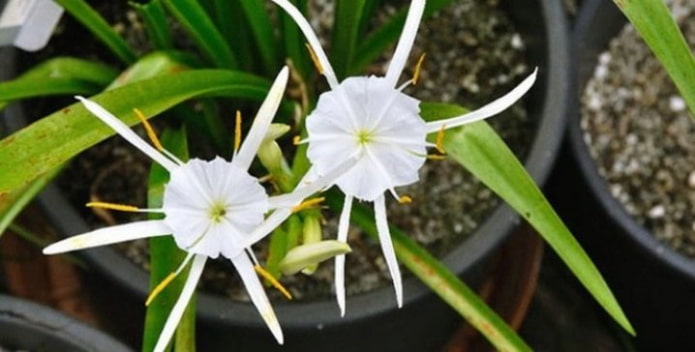
Zantedeschia
More commonly known is the second name – calla. One of the most spectacular plants in the catalog of bulbous plants. Graceful leaves, large multi-colored buds – a flowerpot with zantedeschia will decorate any room.
The homeland of calla is South Africa, so caring for the plant in the middle zone is not so simple. It requires warmth and bright light, but at the same time high humidity and frequent watering (since it grows in marshy areas and coastal zones).
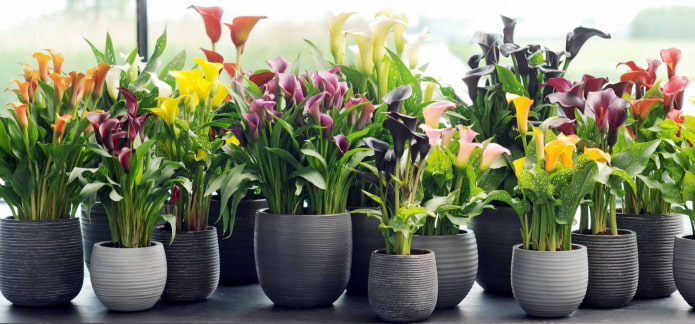
Crinum
The main distinguishing feature of this species of Amaryllidaceae is its size. The bulbs are large, the leaves reach 150 cm in length. Crinums are considered ideal candidates for landscaping spacious halls, cool rooms, winter gardens.
Unpretentious “giants” can grow in both direct and diffused light, at any humidity. The main thing is not to dry out the earthen lump and add nutrients a couple of times a month (during active growth).
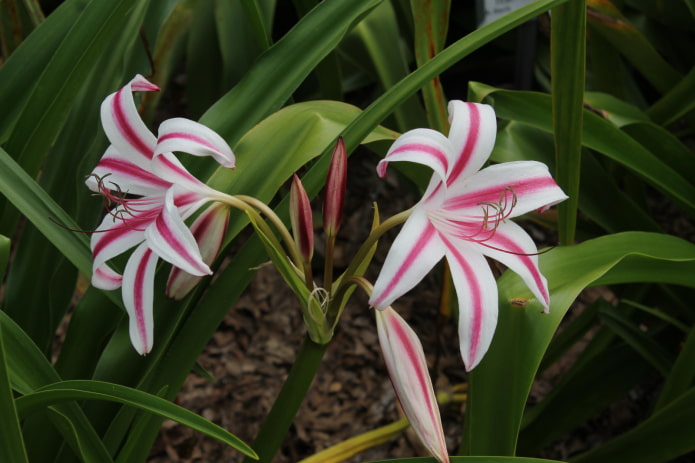
Eucharis
For its characteristic white flowers and widespread distribution in the deltas of the river of the same name, the flower was nicknamed the “Amazon lily”. They bloom profusely – in one umbrella on a long arrow from three to ten buds. But you can also grow for the sake of greenery – large, fleshy, very beautiful leaf blades.
Water regularly, not allowing the soil to dry out. Transplant rarely, only during the dormant period – preferably by transshipment. They reproduce by division (breaking the bush into fragments of 4-5 bulbs) or by seeds, which are formed after flowering.
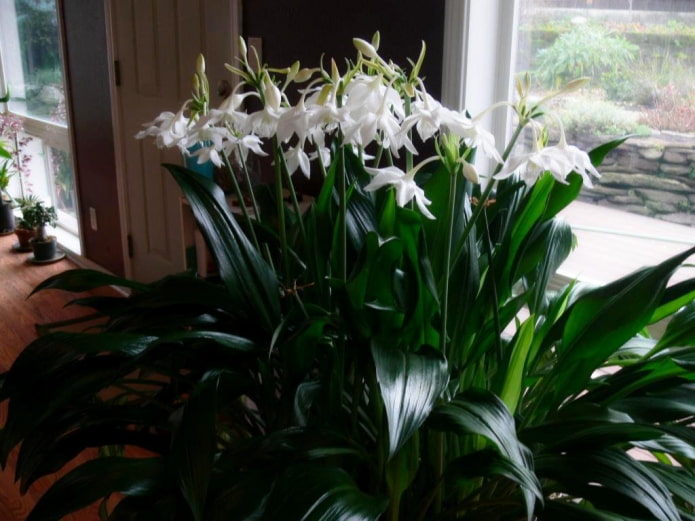
Haemanthus
These bulbous indoor flowers are extremely unusual: their leaves have a soft pubescence, and the flowers look like fluffy balls of pistils and stamens. The plants are considered poisonous, but only the bulb contains dangerous substances — the tops are safer.
This flower has an undeniable advantage over many bulbous plants: it retains its decorative appearance all year round, without going dormant.
The plant is usually unpretentious: it grows on any windowsill, does not suffer from low humidity, and requires replanting extremely rarely (once every 4-5 years).
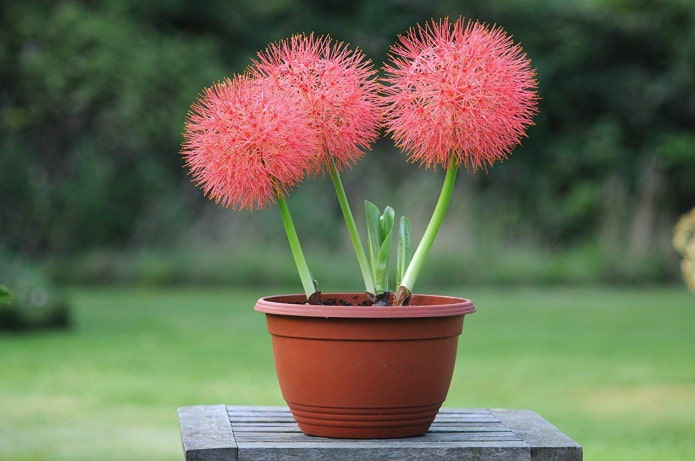
Vallota
Another perennial amaryllis, similar to hippeastrum — the only visual difference is in size. The leaves are narrow, up to 30 cm. The flowers are medium-sized – about 5 cm in diameter, in the form of bells. The buds are formed in late summer, remain open for 4-5 days. An adult developed plant can bloom twice a year.
Important! Replant vallota very carefully, trying not to damage the bulb or roots – otherwise the root system will simply begin to rot and the plant will die.
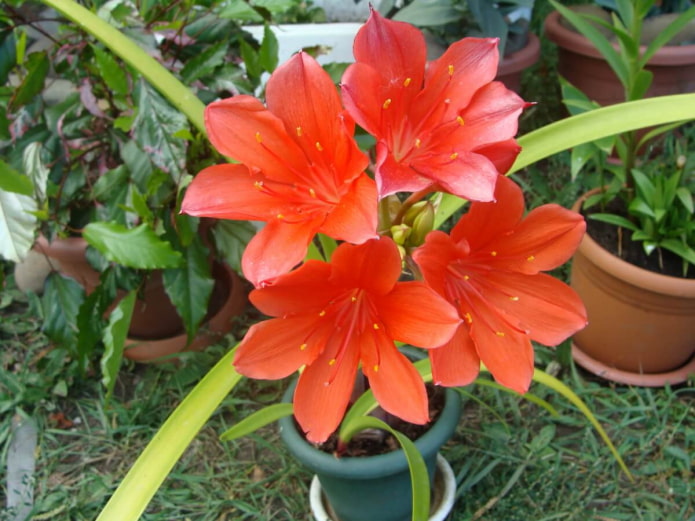
Veltheimia
An unusual and larger version of hyacinth: the flower grows up to 0.3-0.5 m in height. Pink flowers do not have petals, they look like caterpillars hanging from one stem. Flowering occurs in winter, so the flower is also called a winter rocket or torch.
The problem with growing veltheimia is that it likes low temperatures (it blooms only at 14-15 degrees). Therefore, it is quite difficult to achieve flowering in an apartment with central heating: but in a private winter garden there is a high probability of seeing the beauty of the plant.
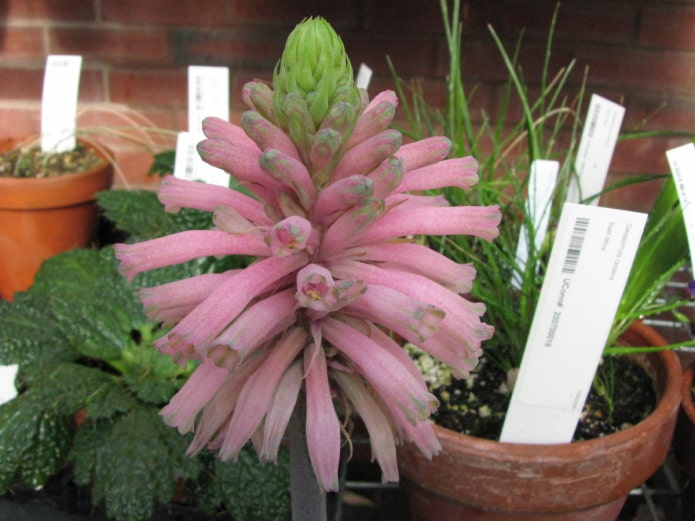
Gloriosa
One of the few bulbous plants with climbing stems. The flower’s homeland is Africa, so its growth in apartments cannot be called fast. But gloriosa blooms for a long time – from July to October. Tropical flowers are decorated with red petals with a yellow border, somewhat reminiscent of tongues of flame.
Planting is possible in any universal soil, but the air humidity must be high. It grows best in light, but cool (up to 20 degrees) rooms.
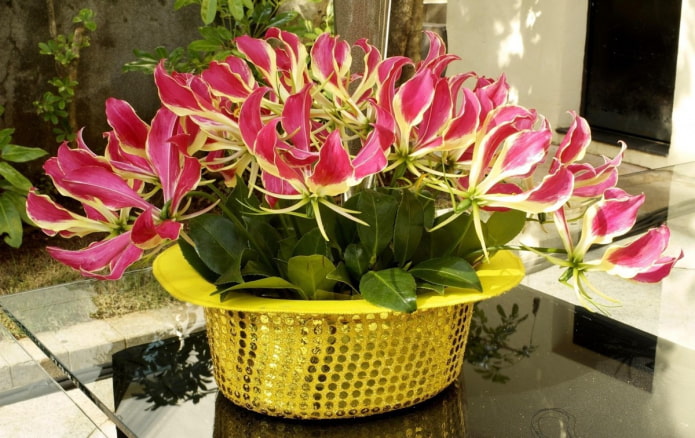
Boevia
Like the previous specimen, the stems of boevia are curly. An exotic plant with a huge bulb and curly “hair” looks very unusual, but be careful: the flower is extremely poisonous. The juice that gets on the skin can cause severe irritation.
The tropical beauty needs to be protected from excessively scorching sun and stagnant water, and also keep in mind that boevia likes low air temperatures.
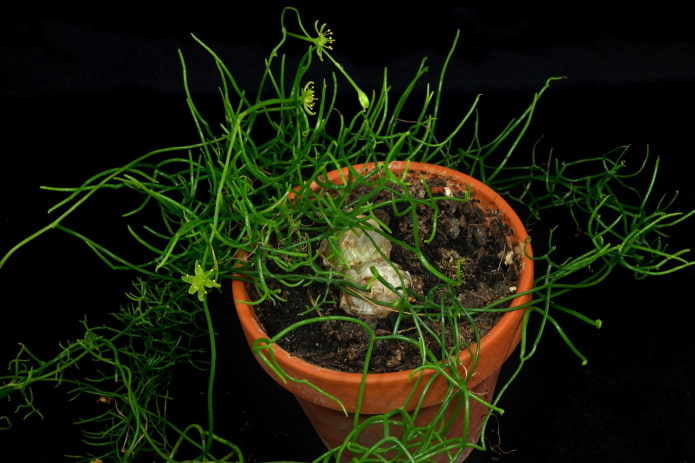
Ledebury
An indoor daylily with contrasting, spotted leaves is good even without flowers. Moreover, it blooms extremely inconspicuously, so it is worth starting primarily for the sake of greenery. More precisely, gray-white-purple “tops”.
It grows slowly, and definitely requires a period of rest in a cool (up to 15C) place. During active growth, it needs long daylight hours and regular watering.
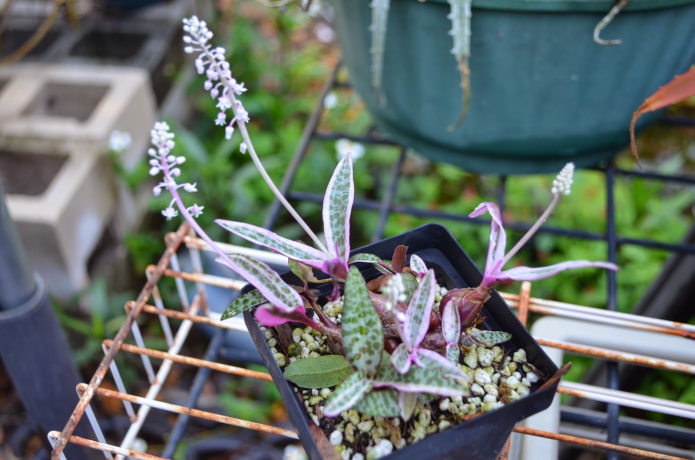
Eucomis
For its inflorescences resembling an exotic fruit, this member of the Asparagus family is popularly called “pineapple”. Landscape designers love these lush shrubs, but they look no worse in interiors.
The wide, wavy leaves of a fresh green color, coupled with unusual flowers, will decorate any room. Eucomis needs bright sun and high humidity, so it should be placed on a southern or eastern window, placing a container of water or a humidifier nearby.
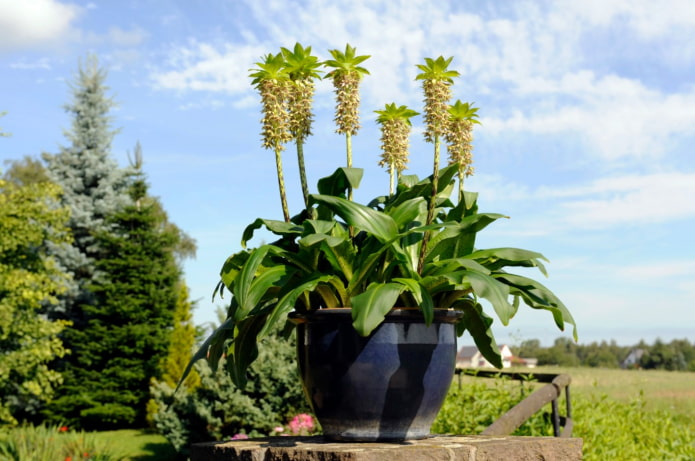
Drimiopsis
A perennial bulbous flower with light spotted leaves and not very noticeable small flowers (in the photo). To achieve maximum decorative greenery, the pot is exposed to bright light – in fact, this is the most important thing when growing drimiopsis.
Watering, fertilizing and humidity are, of course, necessary, but not so mandatory – the plant is not picky about them.
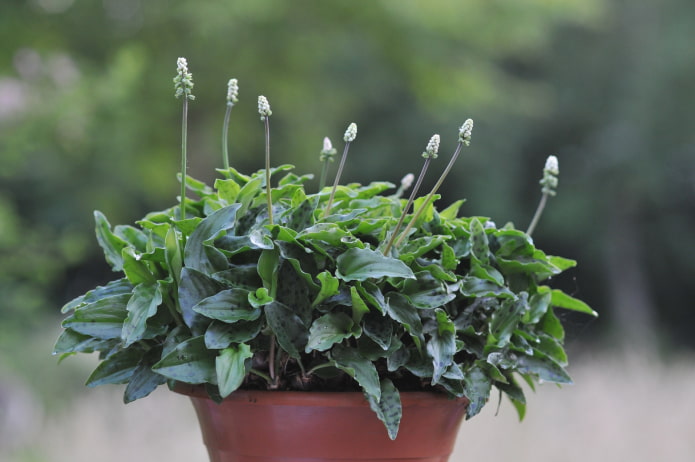
Lashenalia
Or lachenalia. The aloe-like variety is most often grown: it got its name for its dense, curved leaves, similar to aloe, with dark specks. The peduncle is tall with many separate narrow tubular buds, painted in a tropical palette – yellow, orange, scarlet.
One of the advantages of the plant is that it is practically not attacked by pests, it can only get sick due to rotting of the bulb. Therefore, adjust the watering and put the flower in the sun to provide it with comfortable conditions.
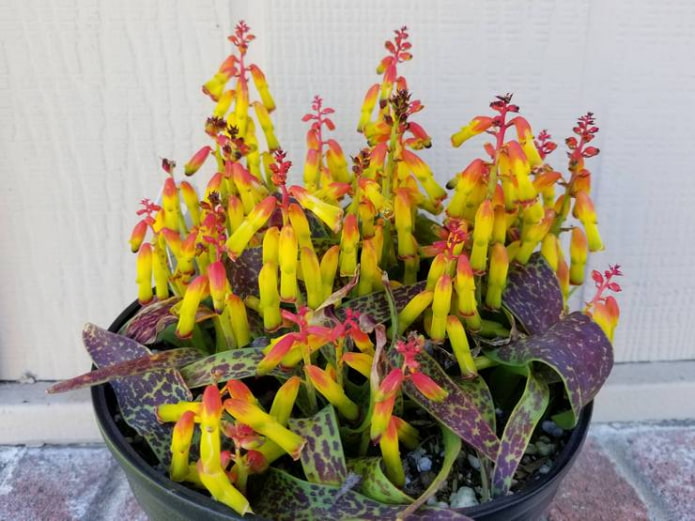
Ornithogalum
Many species are cultivated, but among them there are poisonous ones containing alkaloids and glycosides. It can be grown both in a pot and in the ground.
Decorating a windowsill with this bulbous plant with small cute white flowers does not require much effort – ornithogalum practically does not need special attention. Care is simple: plant in well-drained soil, put in light partial shade, provide moderate watering. All that remains is to water, waiting for flowering in late spring – early summer.
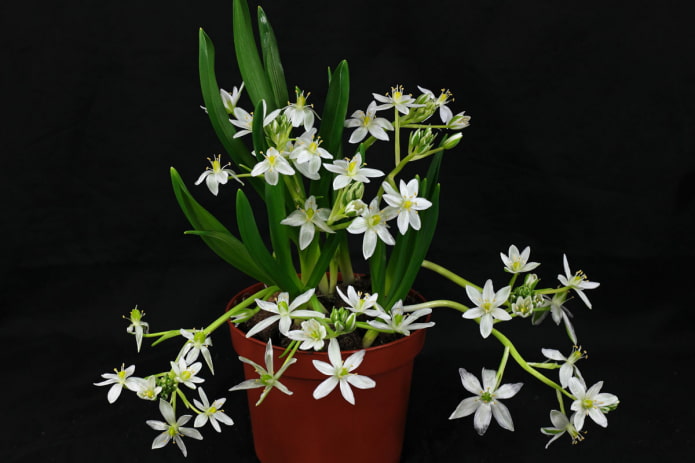
Albuca
One of the most unusual flowers on our list. Firstly, albuca is a succulent. Secondly, it has unusual curly leaves. Thirdly, the name is translated as “shoot white”, which fully characterizes the plant during the flowering period.
Like any succulents, albuca should not be sprayed, and it needs to be watered extremely rarely. It is grown in soil with excellent drainage, placing the planted flower in a warm place.
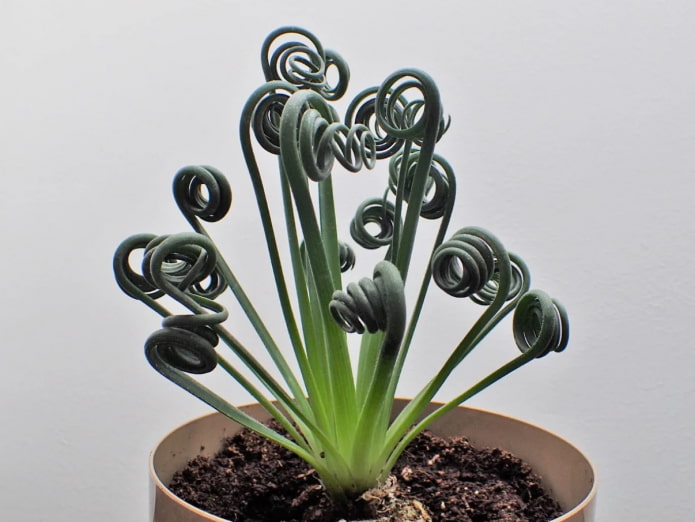
Nerine
It is logical to finish the list with a representative of the most extensive bulbous family – Amaryllis. It differs from others by its thin, long leaf blades and umbrella-shaped flowers, collected in 5-6 pieces.
During the active period, a high temperature is necessary, but when dormant, it is better to put it in a dry, cool (up to 10 degrees) place. It blooms in autumn: in September-October.
Important! The list above does not include clivia – this flower, despite its direct relation to amaryllis, does not have a bulb.
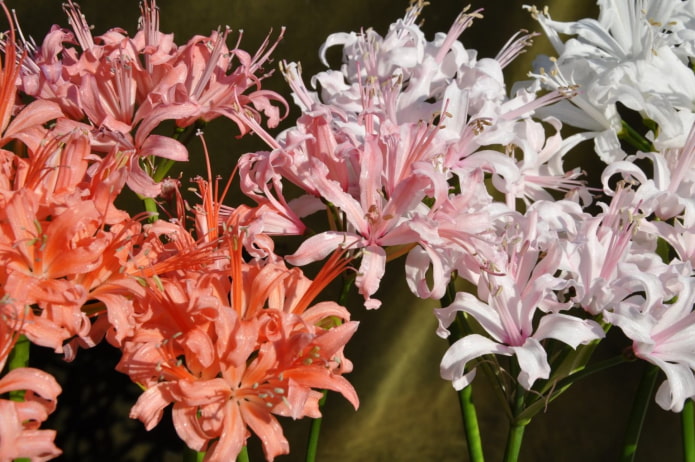
When choosing bulbous plants, remember: many of them need cool storage during the dormant period. This is the only way to achieve abundant re-flowering and excellent well-being of the flower.